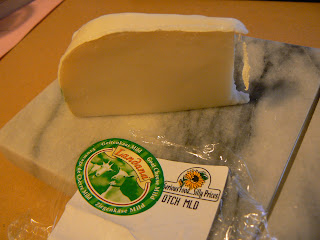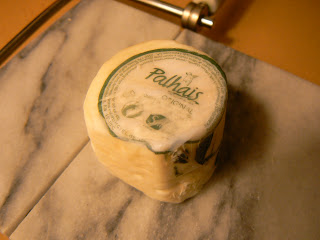In my younger and less cheese-filled years I was a student at Broad Rock Middle School, at the time a brand new facility full of potential and hope. Memories from this period of my life are generally pleasant; the occasional school trip, passing notes, the usual, but only one relates in any conceivable way to cheese.
There was one substitute teacher known only as "Mr. Dan", a laid-back young man who rocked a ponytail and was the subject of countless rumors and stories among the kids. Naturally my lit class was thrilled when we heard he'd be teaching us for the day and, paying lip service to the day's reading, we waited for some classic Mr. Dan hijinks. When it came my time to read I got up and, being the rather shy and quiet 7th grader that I was, stumbled through two or three paragraphs before mercifully "popcorning" to someone else. I'm still not sure why we always said "popcorn Jimmy (or Sally or other names my classmates definitely had)" when we wanted to pass the reading off, there was never actually any popcorn involved and reading aloud was still boring.
In any case, Mr. Dan stepped in before Jimmy could start and asked me to read the last sentence again. He was under the impression that 7th grade me, mischievously trying to mess with the sub, was putting on a voice, a funny accent. Having never stood accused of faking accents before I only managed a feeble "no", which prompted him to start guessing where I, and my accent, were from. His first and most logical guess was Amish Country, my second original accusation in as many minutes. It was a good day. Perhaps the Amish have a famous accent that I've never heard about, perhaps it's very similar to mine, perhaps he was just a space cadet, but for the rest of the year I was called Amish Boy. True story.
With that flawless intro I present to you
Salemville Amish Gorgonzola. Though they may be better known for their closed communities, buggy riding, and totally righteous beards, they also cut a mean curd. That's some cheese-production lingo for you, impress your friends. A co-op within an Amish community in Wisconsin produces three varieties of blue cheese under the Salemville label, and along with the novelty comes some more tangible benefits. Through small herd sizes, hand milking, and strict quality control on what the cows eat, the Amish maintain a consistently high quality product.
Origin: Wisconsin, USA
Milk: Cow, pasteurized
Rennet: Not suitable for a vegetarian diet
Affinage: 90 days
Notes: Hand cut, pressed, turned, washed, weighed, wrapped, delivered, and eaten.
Thoughts: Before reviewing this worthy cheese there is one issue to address. Although it is marketed as Gorgonzola, it is not. Just like every bottle of the bubbly is not technically Champagne, not every creamy blue cheese is Gorgonzola. True Gorgonzola is produced in specified regions of Italy under close regulation, earning the fame associated with the name and protected, in theory, under
EU law. It's pretty safe to say that the Gorgonzola on your last "quattro fromaggi" pizza wasn't imported from Italy, either. The good news is that, like that pizza, domestic Gorgonzola can still be delicious. This particular nomenclative interloper has a mild but pronouncedly pungent aroma, followed by a similarly mild bite and a richly creamy texture. Perfectly salty without being overbearing or mineraly, Amish Gorgonzola is a great and reasonably priced staple blue cheese, begging to be crumbled on top of buffalo-chicken pizza or your next steak.
People often ask me what country makes the best cheese, a question I've never been able to fully answer. The reflex response might be France, but if I could only eat French cheeses I would eventually begin to crave Spanish Cabra Romero, American Midnight Moon, and so forth. The beauty that is the wide variation in cheese makes no one country the sole King(or Queen), and even France is home to some cheeses to avoid. Rather, countries generally have their own characteristic cheeses and moreover their own characteristic cheese traits. When you look at a cheese with a more holistic approach, as a product of what the animal has eaten, where the herd pastures, geography, tradition etc, it follows to reason that trends appear within countries. HINT: This is a big factor in why the sheep eating flower petals and such on the hills of Corsica make a tastier cheese than the ones shackled inside a Kraft factory eating corn.
Salt. That little detour was supposed to wrap up nicely with Italian cheeses being, on the whole, rustic, savory, and salty, bringing us to our next cheese:
Pecorino Ginepro. And here we are.
The Pecorino family of cheeses was largely a mystery to me until I began work at the Cheese Importers, where I learned that there is more out there than just the grating/pasta cheese Pecorino Romano. As the name implies, pecora being Italian for sheep, Pecorinos are all made from ewe's milk and carry that characteristically savory flavor. Pecorino Ginepro, however, is instantly distinguishable from its cousins by the deep purple rind, an indicator of its unique flavor characteristics. What in the wild might mean "stay away I'm poisonous" here means "nah man it's cool I've just been bathed in Balsamic vinegar and juniper berries, I'm totally delicious and toxin-free".
Origin: Italy
Milk: Sheep, unpasteurized
Rennet: Definitely from an animal
Affinage: 4 to 6 months
Notes: Because balsamic vinegar wasn't already tasty enough on salad.
Thoughts: Like many other firm and semi-firm sheep's milk cheeses, the first and most notable flavor characteristics of this cheese are grassy and savory, drawn out and highlighted by faint salty tones. In fact this cheese is considerably earthier than the more well known sheep's cheeses of the world, such as Spain's
Manchego. What alone would be a solid if uninspired cheese is shocked to another level by the treatment process it undergoes. You can even see in the picture how the vinegar bath has permeated the paste, and the flavor goes considerably deeper than the coloring would suggest. Here the palate really is shocked to find that acidic sweetness that makes balsamic vinegar so desirable, in stark contrast to the otherwise reserved flavors of the paste. These opposing tastes play off of each other nicely and the texture breaks down perfectly to create a unique experience.
Sticking with sheep's milk we come to another cheese that draws its defining character from its locale, the romantically named
Brin d'Amour. Meaning strand or bit of love, this cheese presents an interesting case for classification. It is a sheep's milk cheese, brie-like in texture only, technically French but lacking similar cheeses in any country, and imbued with the unique flavor of the island from which it hails: Corsica. It is sold at a variety of ages and occasionally even contains goat's milk.
Origin: Corsica, France
Milk: Sheep, raw
Rennet: As with the majority of mainland European cheeses, animal derived.
Affinage: 4-6 weeks.
Notes: This sample was covered in rosemary, thyme, and coriander, though they lost some of their original bounce and color on the way to America.
Thoughts: As usual, I set this cheese out to warm up before tasting it and returned sometime later to find the paste had spread out to the entire area of the small plate it was sitting on. This is a good sign in a brie. The sweetness of the paste (I would not recommend eating the rind, or rather I would recommend it but only for educational purposes. The dried and thus slightly bitter herbs do not compliment the flavor) was actually surprising, and the texture is so smooth and runny that the smallest details of flavor are magnified tenfold. Still Brin d'Amour is never heavy on the palate, maintaining it's light presence through the fruity and herbal tones of the rind. After the initial sweetness, herbal is truly the dominant flavor, complimented by but stronger than the usual grassy and savory tones of the sheep's milk. This cheese begs to be paired with a fruity red wine and crisp pear slices, though it could also hold its own simply spread onto bread or crackers.
Caution
If you are reading this and are Amish, you might not actually be Amish. You might just have a righteous beard. 














